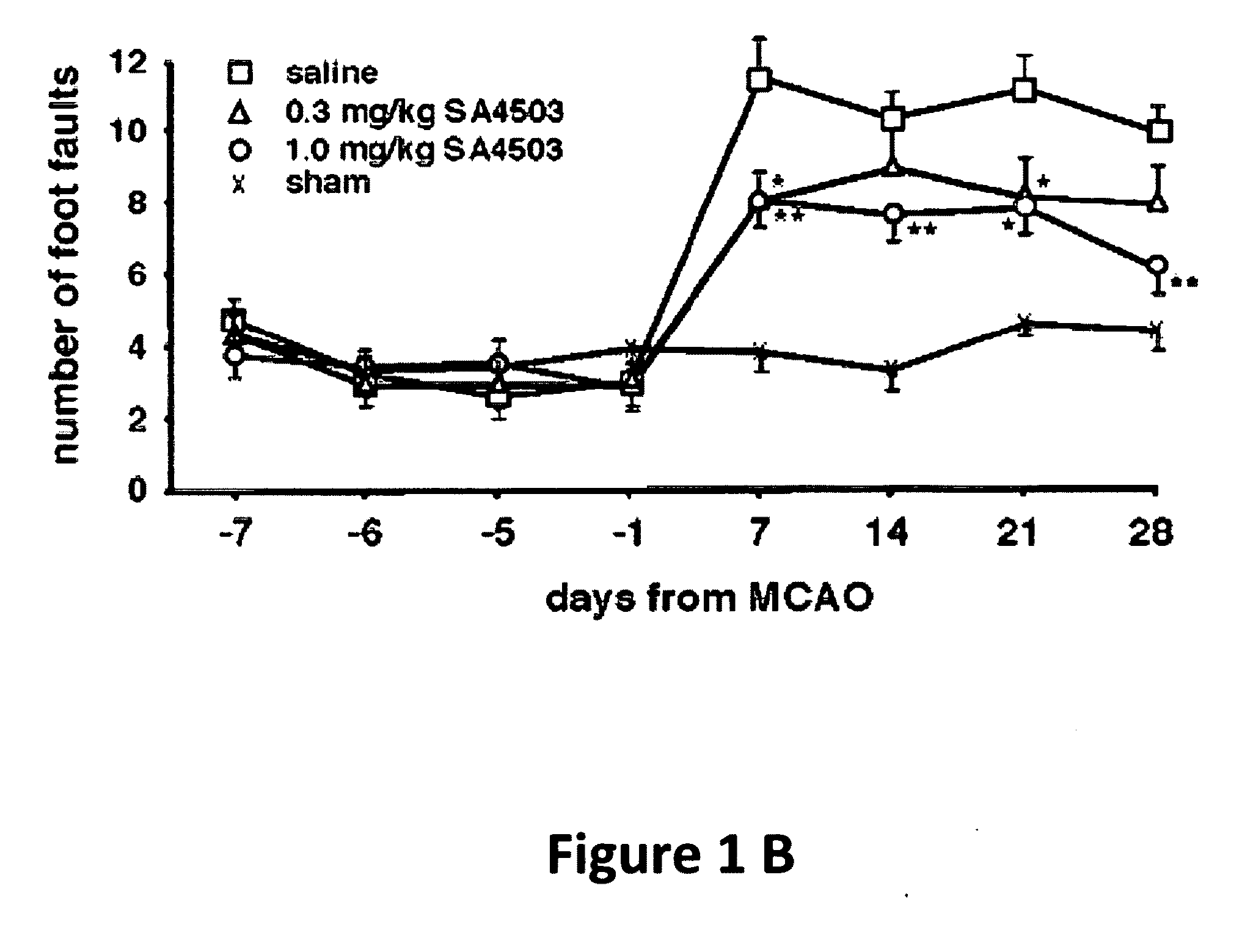Sigma ligands for neuronal regeneration and functional recovery
a neuronal regeneration and functional recovery technology, applied in the field of methods, can solve problems such as paralysis, speech problems and dementia, and achieve the effect of enhancing functional recovery and neuronal regeneration
- Summary
- Abstract
- Description
- Claims
- Application Information
AI Technical Summary
Benefits of technology
Problems solved by technology
Method used
Image
Examples
example 1
Animal Models for Neuronal Regeneration
[0101]Male 3 months old SHR (spontaneous hypertensive) rats are used for induction of stroke by MCA occlusion. This is the preferred strain since most stroke patients are hypertensive. The animals are anesthetized with Methohexital and a small craniectomy is made above the zygmotic arch to expose the middle cerebral artery, which is occluded with a 10-0 monofilament nylon thread distal to the origin of the striatal branches. The rats are not intubated and no catheters are inserted. Following MCA occlusion a large and reproducible infarct is obtained, leading to a robust sensorimotor deficit. The animals are kept on a 6 hr light / 18 h dark cycle with free access to food and water. At two days after the MCAO the rats are treated with the compound I, II, DI, IV, V, VI, VII, VIII, or IX (0.03-10 mg / kg) s.c. or p.o. and a control, group is given saline for 2-8 weeks. At 2, 4, 6 and 8 weeks animals are tested in the rotating pole or...
example 2
AGY-94806 Enhances Functional Recovery
[0113]AGY-94806 (also designated SA4503), 1-(3,4-dimethoxyphenethyl)-4-(3-phenylpropyl)-piperazine dihydrochloride, is a water soluble, selective sigma-1 receptor agonist with efficient brain uptake. The effect of the compound on the recovery of motor function was investigated in two models of experimental stroke. In the first model, spontaneously hypertensive rats were subjected to pMCAO that causes a large cortical infarct and severe motor deficit (FIG. 1A).
Evidence of Neuronal Regeneration in Rats Treated with AGY-94806
[0114]Thirty five spontaneously hypertensive rats were exposed to permanent middle artery occlusion (MCAO), then divided into three treatment groups. Starting at two days after occlusion and continuing daily until 28 days after occlusion, AGY-94806 was administered s.c. in doses of 0.3 mg / kg (12 rats) or 1.0 mg / kg (12 rats). In a control group (11 rats), vehicle only was administered. At the start of treatment, and at several t...
example 3
Further Evidence of Neuronal Regeneration in Rats Treated with AGY-94806
Cylinder Test
[0119]Forty three spontaneously hypertensive rats were exposed to permanent middle artery occlusion (MCAO), then divided into three treatment groups. Starting at two days after occlusion and continuing daily for 14 days, AGY-94806 was administered p.o. in doses of 0.1 mg / kg (14 rats) or 0.3 mg / kg (14 rats). In a control group (15 rats), vehicle only was administered. At the start of treatment, and at several time points during the test, the rats were assessed for their performance in the cylinder test. This test is described in Example 1. It measures the sensory-motor performance of the animals. The performance of the rats in the test was assessed one day before permanent MCAO, then at 14 days, 28 days and 59 days after permanent MCAO. The rats were monitored as they moved freely in a 20 cm-wide clear glass cylinder. Contacts made by each forepaw with the cylinder wall while rearing were scored by a...
PUM
| Property | Measurement | Unit |
|---|---|---|
| time | aaaaa | aaaaa |
| concentration | aaaaa | aaaaa |
| particle size | aaaaa | aaaaa |
Abstract
Description
Claims
Application Information
 Login to View More
Login to View More - R&D
- Intellectual Property
- Life Sciences
- Materials
- Tech Scout
- Unparalleled Data Quality
- Higher Quality Content
- 60% Fewer Hallucinations
Browse by: Latest US Patents, China's latest patents, Technical Efficacy Thesaurus, Application Domain, Technology Topic, Popular Technical Reports.
© 2025 PatSnap. All rights reserved.Legal|Privacy policy|Modern Slavery Act Transparency Statement|Sitemap|About US| Contact US: help@patsnap.com



